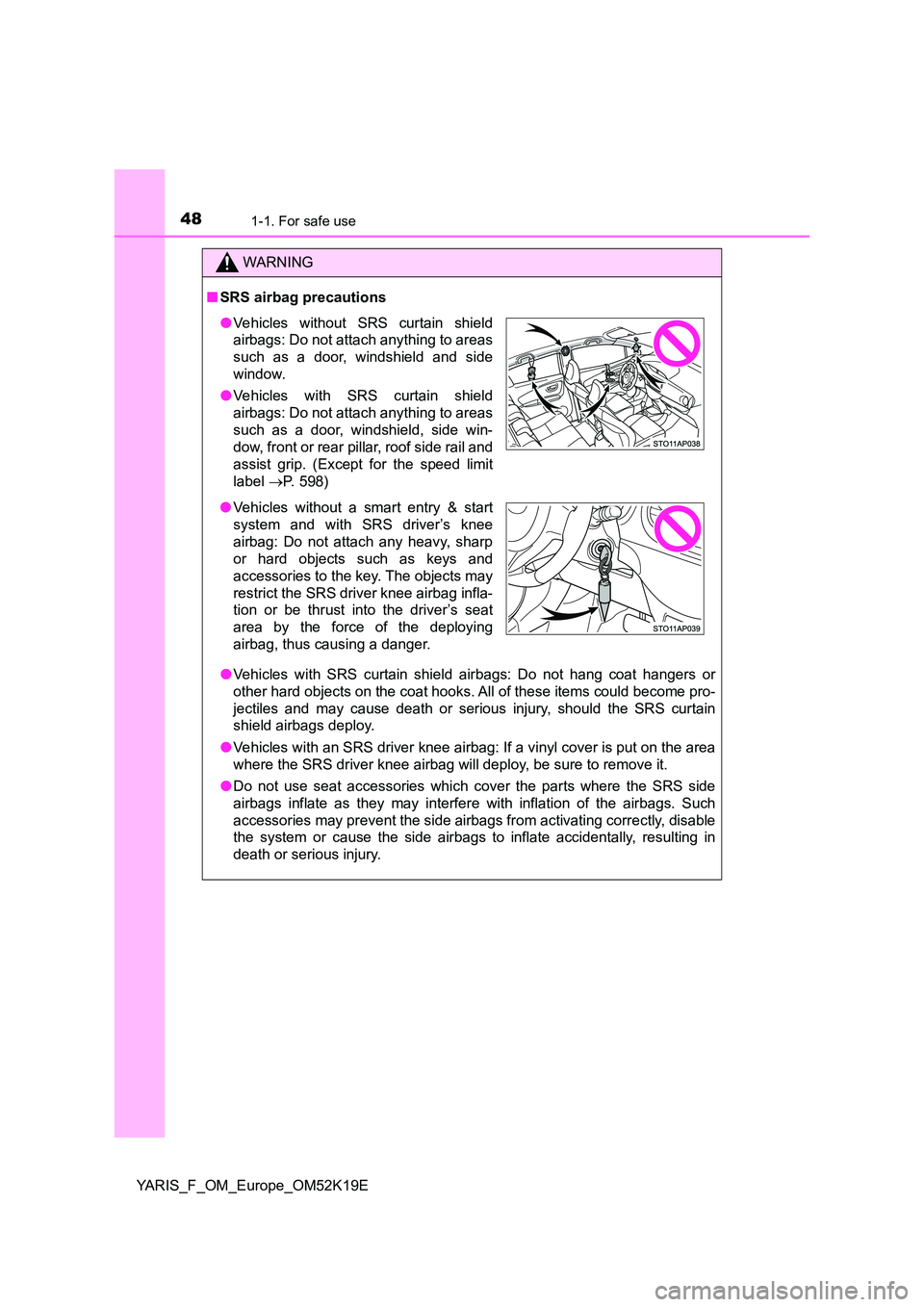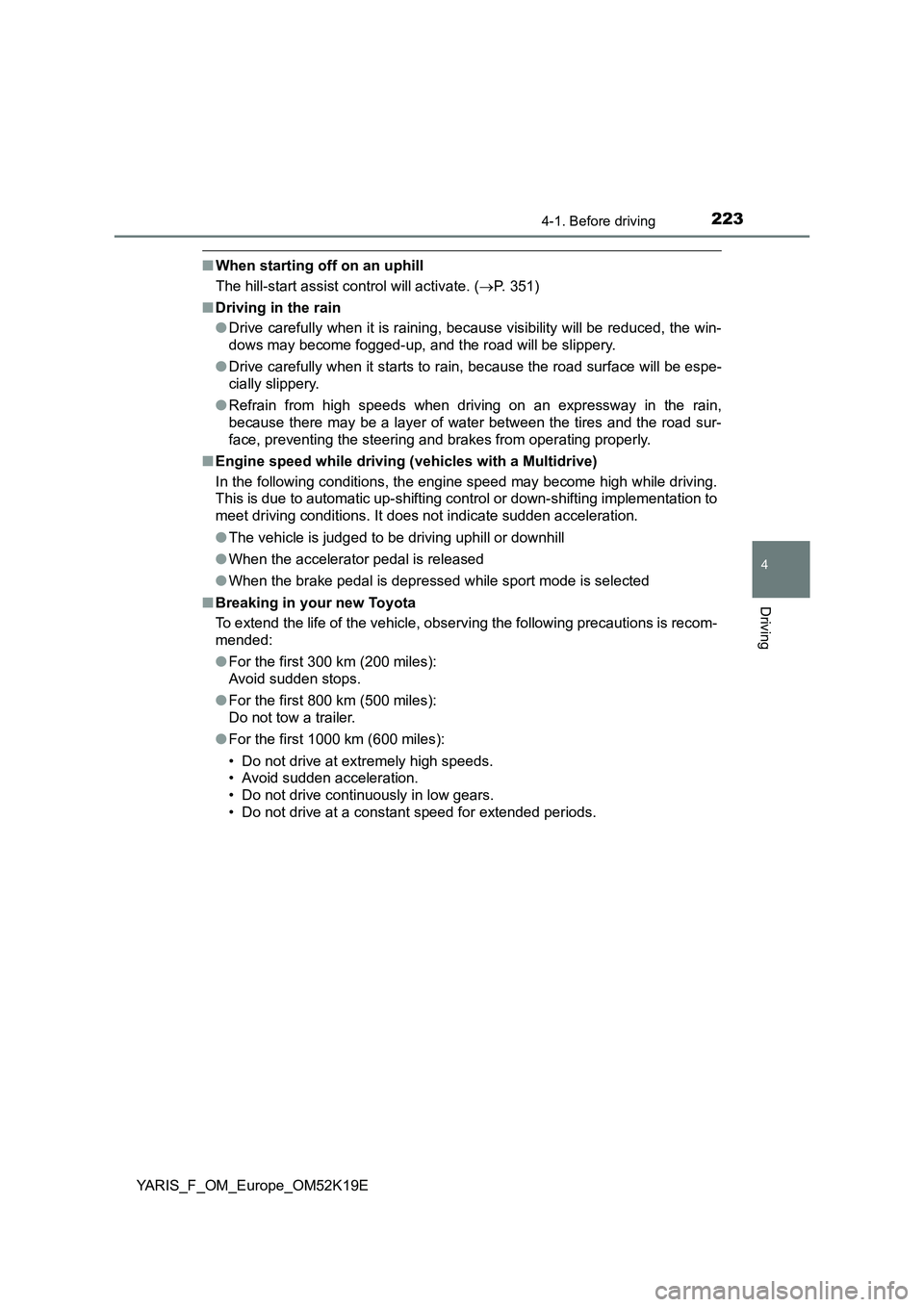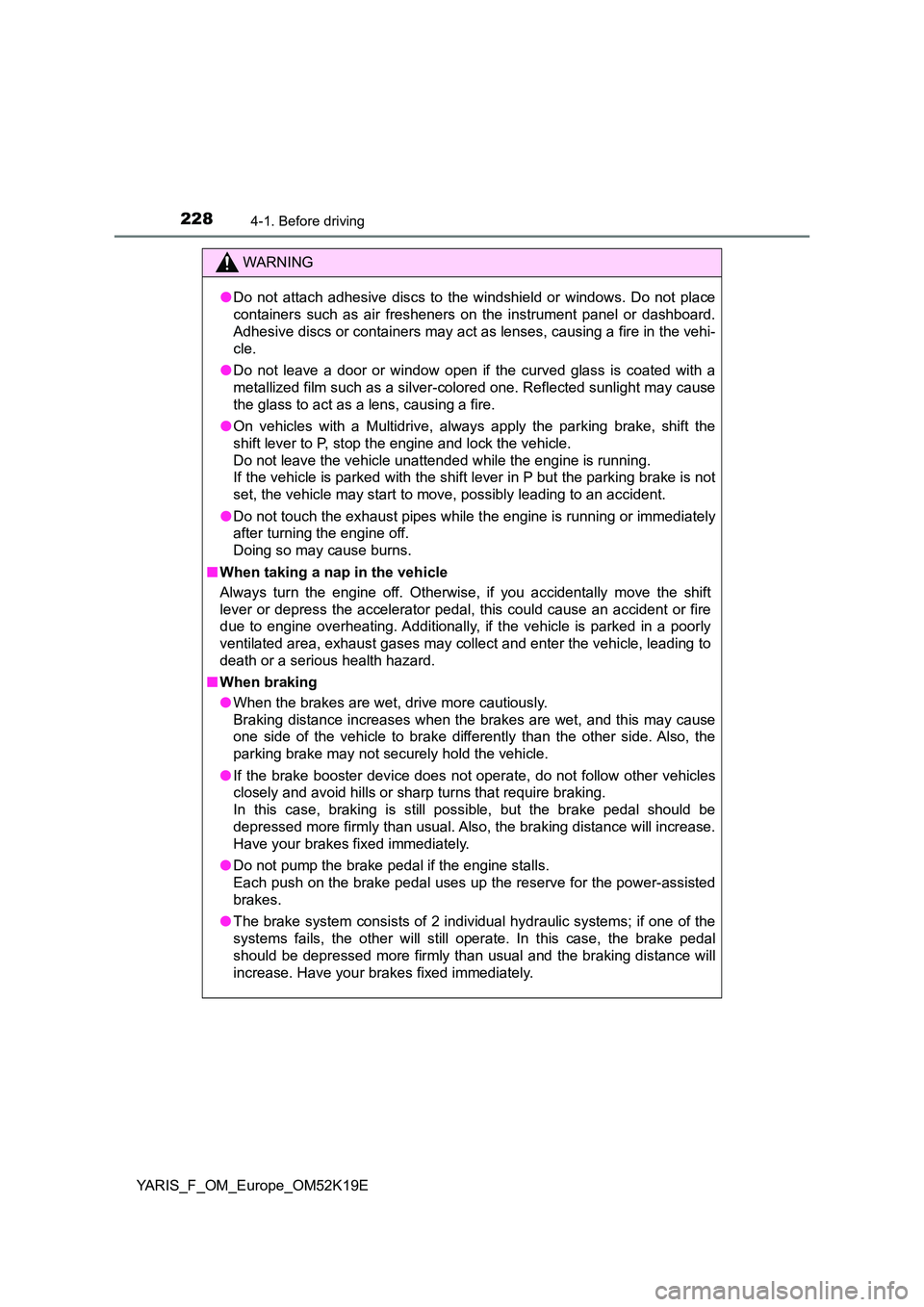2019 TOYOTA YARIS start assist
[x] Cancel search: start assistPage 4 of 700

TABLE OF CONTENTS4
YARIS_F_OM_Europe_OM52K19E
4-5. Toyota Safety Sense
Toyota Safety Sense .........285
PCS
(Pre-Crash Safety
system) ............................293
LDA
(Lane Departure Alert) .....310
Automatic High Beam ........317
RSA (Road Sign Assist).....322
4-6. Using the driving support
systems
Cruise control.....................328
Speed limiter ......................332
Stop & start system............337
Driving assist systems .......348
4-7. Driving tips
Winter driving tips ..............355
5-1. Basic Operations
Audio system types ........... 360
Steering wheel audio
switches .......................... 362
AUX port/USB port ............ 363
5-2. Using the audio system
Optimal use of the audio
system............................. 364
5-3. Using the radio
Radio operation ................. 366
5-4. Playing audio CDs and
MP3/WMA discs
CD player operation .......... 370
5-5. Using an external device
Listening to an iPod........... 379
Listening to a USB
memory device ................ 387
Using the AUX port ........... 394
5Audio system
Page 48 of 700

481-1. For safe use
YARIS_F_OM_Europe_OM52K19E
WARNING
■SRS airbag precautions
● Vehicles with SRS curtain shield airbags: Do not hang coat hangers or
other hard objects on the coat hooks. All of these items could become pro-
jectiles and may cause death or serious injury, should the SRS curtain
shield airbags deploy.
● Vehicles with an SRS driver knee airbag: If a vinyl cover is put on the area
where the SRS driver knee airbag will deploy, be sure to remove it.
● Do not use seat accessories which cover the parts where the SRS side
airbags inflate as they may interfere with inflation of the airbags. Such
accessories may prevent the side airbags from activating correctly, disable
the system or cause the side airbags to inflate accidentally, resulting in
death or serious injury.
● Vehicles without SRS curtain shield
airbags: Do not attach anything to areas
such as a door, windshield and side
window.
● Vehicles with SRS curtain shield
airbags: Do not attach anything to areas
such as a door, windshield, side win-
dow, front or rear pillar, roof side rail and
assist grip. (Except for the speed limit
label P. 598)
● Vehicles without a smart entry & start
system and with SRS driver’s knee
airbag: Do not attach any heavy, sharp
or hard objects such as keys and
accessories to the key. The objects may
restrict the SRS driver knee airbag infla-
tion or be thrust into the driver’s seat
area by the force of the deploying
airbag, thus causing a danger.
Page 129 of 700

1292. Instrument cluster
2
Instrument cluster
YARIS_F_OM_Europe_OM52K19E
The settings of the following items can be changed, refer to P. 671.
For functions that can be enabled or disabled, the function switches
between on and off each time is pressed.
● LDA (Lane Departure Alert) (P. 310)*1
Select to set up the alert sensitivity.
● RSA (Road Sign Assist) (P. 322)*1
Select to set up the following items.
• Notification method (excess speed/other warnings)
Select to change the notification method of the following warnings to no
notification/display only/display and buzzer.
Excess speed warning:
Warns the driver if the vehicle exceeds the speed displayed on the
speed limit sign on the multi-information display.
Other warnings:
Warns the driver if the system determines that the vehicle is overtaking
when a no overtaking sign is displayed on the multi-information display.
• Excess speed notification level
Select to set the speed threshold over which the excess speed warning
starts to operate when a speed limit sign is displayed on the multi-infor-
mation display.
● Clock
Adjusts the hour and minute, and switches between 12-hour and
24-hour display of the clock. ( P. 131)
Settings display
Page 168 of 700

1683-2. Opening, closing and locking the doors
YARIS_F_OM_Europe_OM52K19E
■ Electronic key battery-saving function
■ Conditions affecting operation
The smart entry & start system uses weak radio waves. In the following situa-
tions, the communication between the electronic key and the vehicle may be
affected, preventing the smart entry & start system, wireless remote control
and engine immobilizer system from operating properly.
(Ways of coping: P. 627)
● When the electronic key battery is depleted
● Near a TV tower, electric power plant, gas station, radio station, large dis-
play, airport or other facility that generates strong radio waves or electrical
noise
● When carrying a portable radio, cellular phone, cordless phone or other
wireless communication device
● When the electronic key is in contact with, or is covered by the following
metallic objects
• Cards to which aluminum foil is attached
• Cigarette boxes that have aluminum foil inside
• Metallic wallets or bags
• Coins
• Hand warmers made of metal
• Media such as CDs and DVDs
● When other wireless keys (that emit radio waves) are being used nearby
● When carrying the electronic key together with the following devices that
emit radio waves
• Portable radio, cellular phone, cordless phone or other wireless commu-
nication device
• Another vehicle’s electronic key or a wireless key that emits radio waves
• Personal computers or pers onal digital assistants (PDAs)
• Digital audio players
• Portable game systems
When battery-saving mode is set, battery
depletion is minimized by stopping the
electronic key from receiving radio waves.
Press twice while pressing and hold-
ing . Confirm that the electronic key
indicator flashes 4 times.
While the battery-saving mode is set, the
smart entry & start system cannot be
used. To cancel the function, press any of
the electronic key buttons.
Page 219 of 700

219
4Driving
YARIS_F_OM_Europe_OM52K19E
4-1. Before driving
Driving the vehicle ............. 220
Cargo and luggage ............ 231
Trailer towing ..................... 233
4-2. Driving procedures
Engine (ignition) switch
(vehicles without
a smart entry &
start system) .................... 243
Engine (ignition) switch
(vehicles with
a smart entry &
start system) .................... 246
Multidrive ........................... 255
Manual transmission.......... 263
Turn signal lever ................ 267
Parking brake .................... 268
4-3. Operating the lights
and wipers
Headlight switch ................ 269
Fog light switch .................. 274
Windshield wiper and
washer ............................. 276
Rear window wiper and
washer ............................. 280
4-4. Refueling
Opening the fuel tank
cap ................................... 282
4-5. Toyota Safety Sense
Toyota Safety Sense ......... 285
PCS
(Pre-Crash Safety
system) ............................ 293
LDA
(Lane Departure Alert) ..... 310
Automatic High Beam ........ 317
RSA (Road Sign Assist)..... 322
4-6. Using the driving support
systems
Cruise control..................... 328
Speed limiter ...................... 332
Stop & start system............ 337
Driving assist systems ....... 348
4-7. Driving tips
Winter driving tips .............. 355
Page 223 of 700

2234-1. Before driving
4
Driving
YARIS_F_OM_Europe_OM52K19E
■When starting off on an uphill
The hill-start assist control will activate. ( P. 351)
■ Driving in the rain
● Drive carefully when it is raining, because visibility will be reduced, the win-
dows may become fogged-up, and the road will be slippery.
● Drive carefully when it starts to rain, because the road surface will be espe-
cially slippery.
● Refrain from high speeds when driving on an expressway in the rain,
because there may be a layer of water between the tires and the road sur-
face, preventing the steering and brakes from operating properly.
■ Engine speed while driving (vehicles with a Multidrive)
In the following conditions, the engine speed may become high while driving.
This is due to automatic up-shifting c ontrol or down-shifting implementation to
meet driving conditions. It does not indicate sudden acceleration.
● The vehicle is judged to be driving uphill or downhill
● When the accelerator pedal is released
● When the brake pedal is depressed while sport mode is selected
■ Breaking in your new Toyota
To extend the life of the vehicle, observing the following precautions is recom-
mended:
● For the first 300 km (200 miles):
Avoid sudden stops.
● For the first 800 km (500 miles):
Do not tow a trailer.
● For the first 1000 km (600 miles):
• Do not drive at extremely high speeds.
• Avoid sudden acceleration.
• Do not drive continuously in low gears.
• Do not drive at a constant speed for extended periods.
Page 225 of 700

2254-1. Before driving
4
Driving
YARIS_F_OM_Europe_OM52K19E
WARNING
Observe the following precautions.
Failure to do so may result in death or serious injury.
■ When starting the vehicle (vehicles with a Multidrive)
Always keep your foot on the brake pedal while stopped with the engine
running. This prevents the vehicle from creeping.
■ When driving the vehicle
● Do not drive if you are unfamiliar with the location of the brake and accel-
erator pedals to avoid depressing the wrong pedal.
• Accidentally depressing the accelerator pedal instead of the brake
pedal will result in sudden acceleration that may lead to an accident.
• When backing up, you may twist your body around, leading to difficulty
in operating the pedals. Make su re to operate the pedals properly.
• Make sure to keep a correct driving posture even when moving the
vehicle only slightly. This allows you to depress the brake and accelera-
tor pedals properly.
• Depress the brake pedal using your right foot. Depressing the brake
pedal using your left foot may delay response in an emergency, result-
ing in an accident.
● Do not drive the vehicle over or stop the vehicle near flammable materials.
The exhaust system and exhaust gases can be extremely hot. These hot
parts may cause a fire if there is any flammable material nearby.
● During normal driving, do not turn off the engine. Turning the engine off
while driving will not cause loss of steering or braking control, but the
power assist to these systems will be lost. This will make it more difficult to
steer and brake, so you should pull over and stop the vehicle as soon as it
is safe to do so.
However, in the event of an emergency, such as if it becomes impossible
to stop the vehicle in the normal way: P. 565
● Use engine braking (downshift) to maintain a safe speed when driving
down a steep hill.
Using the brakes continuously may cause the brakes to overheat and lose
effectiveness. ( P. 255, 263)
● Do not adjust the positions of the steering wheel, the seat, or the inside or
outside rear view mirrors while driving.
Doing so may result in a loss of vehicle control.
● Always check that all passengers’ arms, heads or other parts of their body
are not outside the vehicle.
Page 228 of 700

2284-1. Before driving
YARIS_F_OM_Europe_OM52K19E
WARNING
●Do not attach adhesive discs to the windshield or windows. Do not place
containers such as air fresheners on the instrument panel or dashboard.
Adhesive discs or containers may act as lenses, causing a fire in the vehi-
cle.
● Do not leave a door or window open if the curved glass is coated with a
metallized film such as a silver-colored one. Reflected sunlight may cause
the glass to act as a lens, causing a fire.
● On vehicles with a Multidrive, always apply the parking brake, shift the
shift lever to P, stop the engine and lock the vehicle.
Do not leave the vehicle unattended while the engine is running.
If the vehicle is parked with the shift lever in P but the parking brake is not
set, the vehicle may start to move, possibly leading to an accident.
● Do not touch the exhaust pipes while the engine is running or immediately
after turning the engine off.
Doing so may cause burns.
■ When taking a nap in the vehicle
Always turn the engine off. Otherwise, if you accidentally move the shift
lever or depress the accelerator pedal, this could cause an accident or fire
due to engine overheating. Additionally, if the vehicle is parked in a poorly
ventilated area, exhaust gases may collect and enter the vehicle, leading to
death or a serious health hazard.
■ When braking
● When the brakes are wet, drive more cautiously.
Braking distance increases when the brakes are wet, and this may cause
one side of the vehicle to brake differently than the other side. Also, the
parking brake may not securely hold the vehicle.
● If the brake booster device does not operate, do not follow other vehicles
closely and avoid hills or sharp turns that require braking.
In this case, braking is still possible, but the brake pedal should be
depressed more firmly than usual. Also, the braking distance will increase.
Have your brakes fixed immediately.
● Do not pump the brake pedal if the engine stalls.
Each push on the brake pedal uses up the reserve for the power-assisted
brakes.
● The brake system consists of 2 individual hydraulic systems; if one of the
systems fails, the other will still operate. In this case, the brake pedal
should be depressed more firmly than usual and the braking distance will
increase. Have your brakes fixed immediately.